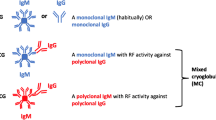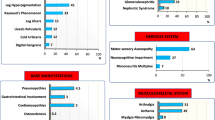Abstract
CryoVas is a small vessel vasculitis associated with the presence of circulating cryoglobulins. In the absence of HCV infection, several disorders have been identified in association of CryoVas. Although evidence is limited, a few studies have recently described the clinical presentation, prognosis, and therapeutic management of non-infectious CryoVas. Patients with type I CryoVas, especially associated with hematologic malignancies, have shown a worse clinical presentation. Recent studies have also identified prognostic factors in mixed CryoVas. Therapeutic management in non-infectious CryoVas remains to be defined. Overall, treatment options should be individualized based on severity of involvement. In this setting, new data have emerged regarding the role of biologic therapy in non-infectious CryoVas. Off-label use of rituximab should be highlighted, based on the assessment of benefits and risks, especially infections.
Similar content being viewed by others
References
Papers of particular interest, published recently, have been highlighted as: • Of importance •• Of major importance
Terrier B, Cacoub P. Cryoglobulinemia vasculitis: an update. Curr Opin Rheumatol. 2013;25:10–8. Comprehensive report with a complete literature review on clinical and laboratory manifestations and new therapeutic approaches of cryoglobulinemia vasculitis.
Lerner AB, Watson CJ. Studies of cryoglobulins I: unusual purpura associated with the presence of a high concentration of cryoglobulin (cold precipitable serum globulin). Am J Med Sci. 1947;214:410–5.
Brouet JC, Clauvel JP, Danon F, et al. Biologic and clinical significance of cryoglobulins: a report of 86 cases. Am J Med. 1974;57:775–88.
Trejo O, Ramos-Casals M, Garcia-Carrasco M, et al. Cryoglobulinemia: study of etiologic factors and clinical and immunologic features in 443 patients from a single center. Medicine (Baltimore). 2001;80:252–62.
Saadoun D, Sellam J, Ghillani-Dalbin P, et al. Increased risks of lymphoma and death among patients with nonhepatitis C virus-related mixed cryoglobulinemia. Arch Intern Med. 2006;166:2101–8.
Ramos-Casals M, Stone JH, Cid MC, et al. The cryoglobulinaemias. Lancet. 2012;379:348–60. An outstanding review with a complete description of pathophysiology, clinical manifestations, diagnosis, and treatment approaches of cryoglobulinemia vasculitis.
Della Rossa A, Tavoni A, Bombardieri S. Hyperviscosity syndrome in cryoglobulinaemia: clinical aspects and therapeutic considerations. Semin Thromb Hemost. 2003;29:473–7.
Gorevic PD, Kassab HJ, Levo Y, et al. Mixed cryoglobulinemia: clinical aspects and long-term follow-up of 40 patients. Am J Med. 1980;69:287–308.
Tzioufas A, Boumba D, Skopouli F, et al. Mixed monoclonal cryoglobulinaemia and monoclonal rheumatoid factor cross-reactive idiotypes as predictive factors for the development of lymphoma in primary Sjogren’s syndrome. Arthritis Rheum. 1996;39:767–72.
Brito-Zerón P, Ramos-Casals M, Bove A, et al. Predicting adverse outcomes in primary Sjögren’s syndrome: identification of prognostic factors. Rheumatology (Oxford). 2007;46:1359–62.
García-Carrasco M, Ramos-Casals M, Cervera R, et al. Cryoglobulinaemia in systemic lupus erythematosus: prevalence and clinical characteristics in a series of 122 patients. Semin Arthritis Rheum. 2001;30:366–73.
Morra E. Cryoglobulinemia. ASH Education Book. Hematol Am Soc Hematol Educ Program. 2005;1:368–72.
Trejo O, Ramos-Casals M, López-Guillermo A, et al. Hematologic malignancies in patients with cryoglobulinaemia: association with autoimmune and chronic viral diseases. Semin Arthritis Rheum. 2003;33:19–28.
Terrier B, Krastinova E, Marie I, et al. Management of noninfectious mixed cryoglobulinemia vasculitis: data from 242 cases included in the CryoVas survey. Blood. 2012;119:5996–6004. This is the largest series so far published on non-infectious mixed CryoVas analyzing the safety and efficacy of different treatment approaches. Rituximab and corticosteroids showed greater efficacy although were associated with severe infections.
Damoiseaux J and Cohen Tervaert JW. Diagnostics and treatment of cryoglobulinemia: it takes two to tango. Clin Rev Allerg Immunol 2013.
Terrier B, Karras A, Kahn J, et al. The spectrum of type I cryoglobulinemia vasculitis. Medicine. 2013;92:61–8. This study describes the presentation, prognosis, and therapeutic management of the largest series of type I CryoVas patients. Severe cutaneous manifestations and high serum cryoglobulin levels characterized type I CryoVas, although the frequency of glomerulonephritis was lower than expected.
Terrier B, Carrat F, Krastinova E, et al. Prognostic factors of survival in patients with non-infectious mixed cryoglobulinaemia vasculitis: data from 242 cases included in the CryoVas survey. Ann Rheum Dis. 2013;72:374–80. This study included 242 patients with non-infectious mixed CryoVas. Causes of death and prognostic factors of survival were assessed and a prognostic score was determined to predict survival at 5 years. Main prognostic factors were age older than 65 years, pulmonary and gastrointestinal involvement, and renal failure.
Terrier B, Semoun O, Saadoun D, et al. Prognostic factors in patients with hepatitis C virus infection and systemic vasculitis. Arthritis Rheum. 2011;63:1748–57.
Terrier B, Launay D, Kaplanski G, et al. Safety and efficacy of rituximab in nonviral cryoglobulinemia vasculitis: data from the French Autoimmunity and Rituximab registry. Arthritis Care Res (Hoboken). 2010;62:1787–95.
Payet J, Livartowski J, Kavian N, et al. Type I cryoglobulinemia in multiple myeloma, a rare entity: analysis of clinical and biological characteristics of seven cases and review of the literature. Leuk Lymphoma. 2013;54(4):767–77.
Nehme-Schuster H, Korganow A, Pasquali J, et al. Rituximab inefficiency during type I cryoglobulinemia. Rheumatology (Oxford). 2005;44:410–1.
Pandrangi S, Singh A, Wheeler D, et al. Rituximab treatment for a patient with type I cryoglobulinemic glomerulonephritis. Nat Clin Pract Nephrol. 2008;4:393–7.
Calabrese C, Faiman B, Martin D, et al. Type 1 cryoglobulinemia: response to thalidomide and lenalidomide. J Clin Rheumatol. 2011;17:145–7.
Lin R, Curran J, Zimmerman T, et al. Lenalidomide for the treatment of cryoglobulinemia and undifferentiated spondyloarthropathy in a patient with multiple myeloma. J Clin Rheumatol. 2010;16:90–1.
Compliance with Ethics Guidelines
Conflict of Interest
Luis R. Espinoza declare that he has no conflict of interest to disclose.
Human and Animal Rights and Informed Consent
This article does not contain any studies with human or animal subjects performed by any of the authors.
Author information
Authors and Affiliations
Corresponding author
Additional information
This article is part of the Topical Collection on Vasculitis
Rights and permissions
About this article
Cite this article
Perez-Alamino, R., Espinoza, L.R. Non-Infectious Cryoglobulinemia Vasculitis (CryoVas): Update on Clinical and Therapeutic Approach. Curr Rheumatol Rep 16, 420 (2014). https://doi.org/10.1007/s11926-014-0420-0
Published:
DOI: https://doi.org/10.1007/s11926-014-0420-0




